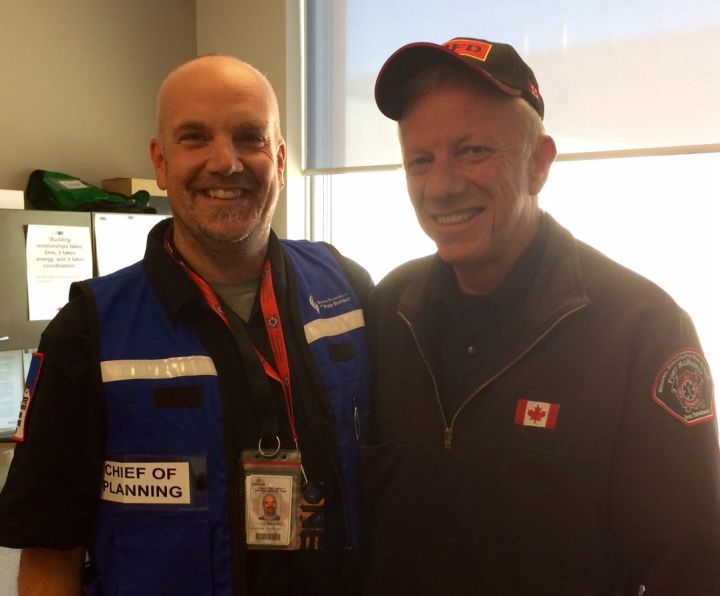It’s been nearly three weeks since Fort McMurray residents were forced to flee their homes as fire raged through the city. But as they were leaving, a specialized team was being assembled – one that would coordinate efforts on preparing the city to eventually welcome its residents back home.

Daryl Black was part of the Provincial Incident Management Team in Fort McMurray from May 8-17. He sat down with Global News to talk about what happens behind the scenes, in an exclusive interview.
Global News: “Tell me a little bit about what you guys do on that team.”
Daryl Black: “Our job is to go in and assist a municipality that has suffered some kind of devastating emergency or disaster. So whether it be the Slave Lake fires, the floods in both Calgary and High River and most recently now, the fires in Fort McMurray, the local municipality is typically pretty overwhelmed dealing with it. We have the ability to go in and prop them up – try to provide order to the chaos that they’ve experienced over the last week or four days – whatever that looks like.”
GN: “When you got up there and you did gain access to Fort McMurray, what were you seeing?”
DB: “One of the first things that struck us when we arrived and drove from the airport to the emergency operations centre was just how quiet it was. Fort McMurray is bustling – there’s trucks, there’s people, all coming and going. But it was eerily quiet. We could see the impacts of the fire right as we flew in. It was humbling and something we had prepared for. But to see it is certainly something else.”
READ MORE: ‘It’s like Armageddon here’: Fort McMurray resident who stayed in town during fire describes city
GN: “You’re tasked with trying to bring order to all of this. What’s the first thing you do when you get in there?”
DB: “We do a very stringent, and as thorough as we can, assessment of where we are at. What are the basic necessities of life? What do we have for ambulances? What is the fire doing? What is the air quality like? All of those types of things we need to really carefully assess. From there, once we have that, we determine what is the risk? What is the benefit to us operating in this environment?”
READ MORE: Phased re-entry into Fort McMurray to begin June 1
GN: “You said you worked with Fire Chief Darby Allen. Everyone knows his name now. What was that like?”
DB: “His charisma and his quiet leadership was something to see. It really, really was. He has a unique ability to make everyone feel welcome and calm people down. During our time up there, there was setback after setback, after setback. You take one step forward and two steps back. Chief Allan was always there. ”
READ MORE: ‘We should be proud’: Fire Chief Darby Allen opens up about Fort McMurray wildfire
GN: “What did you specifically work on? Did you have a project?”
DB: “The area that I worked in and supported was really responsible for a lot of the information gathering. So when the safety code officers go out and do assessments, that information would be fed back to my team. We were essentially the source of truth. Because we do have a lot of stakeholders at play here and it’s critical to have the right information at the right time and validate: okay, what are we looking at here?”
GN: “You guys are working almost in a bubble up there. How important was it for you to be able to gather that truth and then disseminate it to Fort McMurray residents all across the country?”
DB: “One of the greatest challenges we have is taking the information that we’ve gathered, and really circulating it. And even before we circulate it, validate it. Because we understand people are very hungry for information, any information. But we have to balance that need and desire to give information with making sure it’s the right information. And I understand some of the frustration, I get it. Unfortunately if we put out a piece of information that’s incorrect or hasn’t been validated, that becomes fact. And it’s far more difficult to refute that fact once it’s out, then it is to spend a little extra time, or maybe a lot of time, determining what is that information.”
READ MORE: Fort McMurray wildfire: Search these high-resolution satellite maps of the damage
GN: “So now you’ve come back to Edmonton. What is happening up there at this point? Why did you come back?”
DB: “Our task is primarily to stabilize the situation and try to transition it over to a municipality. We’re certainly ready to go back up at a moment’s notice if required. But, from what we can determine at this point, the municipality has it well in hand in partnership with the province.”
GN: “Anything you would want to say to evacuees?”
DB: “Everyone recognizes the challenges everyone is facing. Every day that’s delayed is another day that a single mom with her two kids is sitting in a gym with a cot. Yes, physical basic needs are being taken care of. But I can promise you the people making the decisions understand the sacrifices being made. The need to get back into your community, back into normalcy, back into routine – that fact is first and foremost on everyone’s mind. So while the process is taking longer than a lot of people suspect or would like, I’m sure, I can say with great impartiality that it’s going to be done as right as it possibly can be, as safely as possible. Everyone up there is working to get everyone back home.”
Watch below: Full, extended interview with Daryl Black



Comments